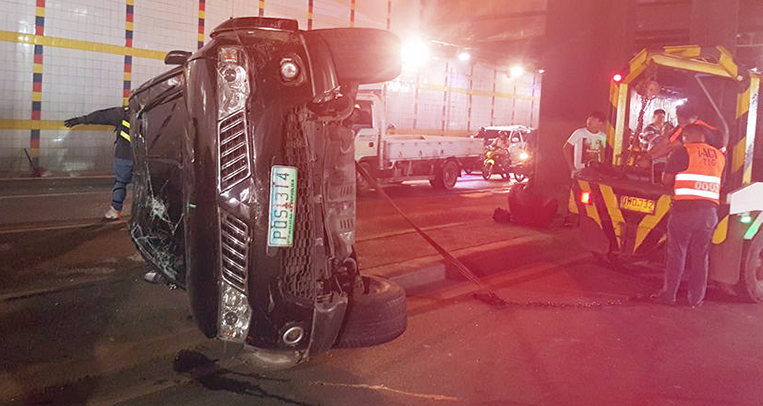
“Kahit F1 [Formula 1] team pa ang maintenance ng Vios mo, pero may underpass na walang ilaw, barriers na hipan lang talsik na at nakakalitong road signs, madidisgrasya ka talaga,” Senator Ralph Recto said in a statement questioning the recently revived Private Motor Vehicle Inspection Center program. You might recall that the Department of Transportation has said in recent days that a PMVIC test will soon be a prerequisite for vehicle registration.
This prompted Recto to release a statement:
[The unpopular private motor vehicle inspection scheme has been] roused from the dead. It has been put into a coma upon orders of Malacañang. Now it appears that it has mutated into something else. [The government has to explain to car owners] the specs of this new order from the Land Transportation Office, whose endorsement of the Private Motor Vehicle Inspection Center services seems to border on the mandatory. Ang pakiusap lang po natin sa ating mga kaibigan sa LTO at DOTr ay ipaliwanag ang pangangailangan nito at ipakita ang legal na batayan kung bakit binuhay nila ang ganitong programa.
Specifically, has the revival of the mothballed PMVIC scheme been given a go-signal by the Office of the President? [The LTO should also demonstrate to the public that the scheme] will not result in long lines, longer processing time, and longer travel time to faraway PMVIC sites.
If a car owner will opt for an inspection done by the LTO, are the facilities of the latter adequate? Is this option available all the time, so they will not be shepherded to private testing centers? Ang ibig po bang sabihin nito, ang isang LTO district office ay may katambal na suking PMVIC at kailangan po bang mag-detour sa PMVIC bago magpa-rehistro?
[If this rule is mishandled by the DOTr] it may tarnish whatever legacy the present administration is trying to build in the transportation sector. To its credit, airports, seaports and railways are being built and completed. Why contaminate a nice report card by forcefully ramming a scheme, which as presented, breeds confusion and complications?
There is no debate as to the need to allow only roadworthy vehicles on our highways. Lahat tayo agree doon. But to blame every road accident on poorly maintained vehicles in marketing PMVICs not only absolves the culpability of reckless drivers but also the failure of government to build safe roads.

The lawmaker makes sense, and any straight-thinking motorist has to agree with him.
But wait…the PMVIC program’s “steering committee” has a reply. Check out this response sent to the motoring media today:
We most welcome and acknowledge the recent statement of the honorable Senator Ralph Recto regarding the Private Motor Vehicle Inspection Center (PMVIC) Program.
Firstly, we thank the good Senator for his appreciation of the legacy accomplishments of the Department of Transportation (DOTr) in the various transportation sectors. This rightfully serves as inspiration and encouragement for all of us to continue with our efforts to implement necessary changes and improvements in our transportation system.
In this desire to improve, enhance and cultivate a culture of discipline, responsibility and awareness amongst the stakeholders, we want to assure the honorable Senator Recto that we are with him in rallying our people to what is right, and not necessarily what is popular, in upholding our nation’s best interest.
We appreciate the concerns raised by the good Senator on the legality of the PMVIC, and the necessity to adopt this comprehensive vehicle roadworthiness inspection system.
In this light, allow us to respectfully stipulate the following:
In the legal opinion of the Office of the Solicitor General (OSG) dated 18 March 2021, OSG said that the Department of Transportation (DOTr) and the Land Transportation Office (LTO) have authority to ensure the roadworthiness of vehicles and consequently implement the motor vehicle inspection system (MVIS).
The Administrative Code of 1987, under Section 3, Chapter 1, and Section 7(4), Chapter 2, of Book IV; Republic Act. 4136 [Section 4(d)(1) and (d)(6)]; EO 125 [30 January 1987]; EO 125-A [13 April 1987] and EO 266 [25 July 1987], signed by then Pres. Corazon C. Aquino, which have the force and effect of law under Section 6, Article XVIII of the 1987 Constitution, are evidence of general grant of quasi-legislative power, or the power of subordinate legislation, and authority to administer motor vehicle inspection, in favor of the DOTr and LTO.
As to the issue of DOTr and LTO authorizing private entities to conduct inspection of motor vehicles, the Administrative Code of 1987 and EO 125-A allows DOTr to call on any corporation or organization, whether public or private, to participate and assist in the implementation of transportation programs.
OSG then clarified that the DOTr is not delegating an already delegated authority to the private sector. Rather, DOTr and LTO are seeking the assistance of the private sector in the implementation of the MVIS, and that the government remains responsible for roadworthiness testing. According to OSG, the MVIS is only outsourced, operated under a private sector participation agreement, but the government still has direct control and supervision of the roadworthiness testing and motor vehicle registration.
In so far as the good Senator is seeking justification that implementing the PMVIC system now “will not result in long lines, longer processing time, and longer travel time to faraway PMVIC sites,” we have fully addressed this with the issuance of DOTr Memorandum Circular (MC) No. 2021-02 or the Implementation of Geographical Area of Responsibility (GAOR) for the renewal of registration for light vehicles and motorcycles, dated July 5, 2021.
The said MC outlines how the LTO will establish the GAOR for every authorized PMVIC for renewal of registration to define areas covered by each facility. This is precisely to prevent crowding and long queues at a particular center since the PMVICs will cater to clients in their respective areas. The GAORs are to be assigned to allow the PMVIC to accommodate clients within its capacity, taking into consideration the health and sanitation protocols, and without causing traffic congestion.
However, motor vehicle owners in areas not under the GAOR may still choose to have their vehicles undergo emission testing at a PETC, and roadworthiness inspection at an LTO office. Thus, there is no need for a detour if there is no PMVIC in the GAOR. Owners may go directly to the LTO for the roadworthiness test after securing an emission testing certificate.
Further, if we look at the premise of the issue, the definitive solution is increasing the number of PMVICs that should open nationwide, in order to for all areas to be covered.
On the matter of “suking PMVIC,” LTO offices with overlapping PMVIC GAORs may accept the result of any PMVIC within their area of coverage.
With regard to the scope of inspection, the PMVIC facility will conduct the full roadworthiness test for the vehicle, including emission test. The basis of renewal of registration shall be the roadworthiness of the vehicle as evidenced in the test results from any PMVIC and PETC, and visual inspection. The other minor test results are supplementary data for consideration.
And, perhaps the most vital issue we have addressed is that even with the full road worthiness inspection of vehicles, owners will only be charged a rate of P600 for light vehicles, and P500 for motorcycles, which are similar to rates collected by a PETC. No additional fees shall likewise be imposed for reinspection or retest.
With these, we wish to gently redirect the misimpression of the honorable Senator that we are marketing the PMVICs as the be-all, end-all solution to minimizing road accidents. Though roadworthiness is not the cure-all for road crashes, it is one of the pillars of road safety. Thus, we remain firm in our commitment to address the roadworthiness requisite prior to renewal of vehicle registration. And, currently, PMVICs are the most equipped facilities which can accurately, efficiently and reliably measure this vital requirement of the law.
We believe that outside of our committee’s mandate, the DOTr and its attached agencies have also been pursuing other road transport initiatives such as the PUV modernization program, LTO demerit system, service contracting, and information and education campaign for road safety, defensive driving, and proper use of roads, in order to mitigate the rise in vehicular accidents, and fully uphold road and public safety, through building adequate transport infrastructure and enhancing driver’s competence.
We strongly agree with the good Senator that road safety is indeed paramount and primordial.
As one of the crucial factors to enhancing road safety, ensuring the roadworthiness of vehicles cannot be postponed.
And every Filipino life that we save and preserve through this measure is a victory for us and our country.

We think we know whose side you’re on. But please feel free to enlighten us. Your comments are most welcome.











Comments